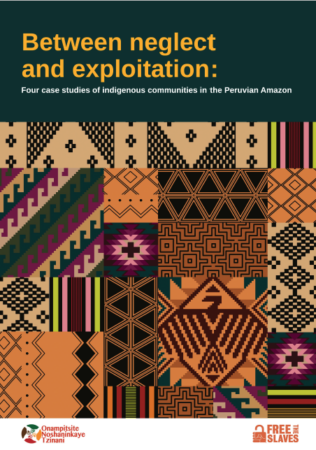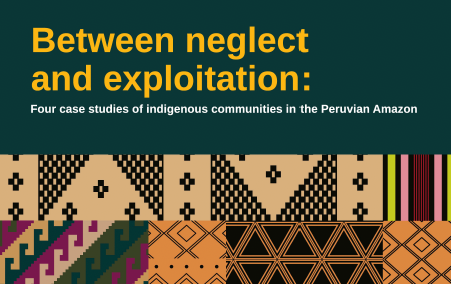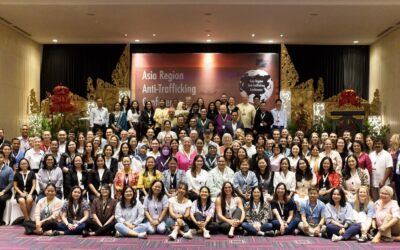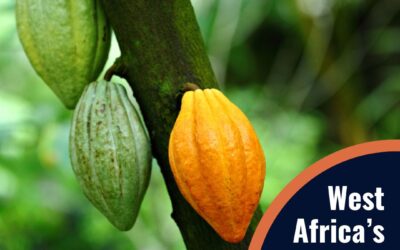An alarming 49.6 million people across the globe suffer from various forms of modern slavery, including 27.6 million entrapped in forced labor and 22 million in forced marriages. A combination of poverty, COVID-19, climate crisis, and regression in social protection has left vulnerable populations like migrants, Indigenous peoples, and LGBTQI+ individuals even more susceptible to exploitation. Our recent study examines the causes of modern slavery in Peru through the experiences of Indigenous people in four regions. Despite efforts such as the National Policy Against Human Trafficking and its Forms of Exploitation 2030, and despite the Constitution prohibiting “slavery, servitude, and human trafficking […] in any of its forms”, slavery and the trafficking of persons continue to be prevalent throughout the country.
In Peru, moreover, slavery and human trafficking are never isolated phenomena. Rather, they intersect with organized criminality, illegal exploitation of natural resources, environmental deterioration, harmful cultural norms, and violations of Indigenous rights to create a reality marked by multiple, interconnected challenges.
A Complex Background
Peru’s rich and diverse landscape, home to 55 Indigenous peoples and 48 distinct languages, is increasingly under threat. With 2,433,314 hectares of Amazon forests lost to deforestation, the ecosystem is rapidly deteriorating.
Deforestation is further exacerbated by activities of illegal mining and logging. Illegal mining, especially of alluvial gold, is a particularly severe problem linked to a variety of illegal activities such as tax evasion, money laundering, environmental crimes, and even homicide. The use of mercury in mining, moreover, poses severe health risks, contaminating air, land, and water, affecting individuals even thousands of kilometers away.
Indigenous community leaders who attempt to oppose illicit activities of resource extraction and advocate for the protection of their ancestral territories face threats and assassinations.
Indigenous Communities at Risk
 A recent study on modern slavery in Peru conducted by Free the Slaves and ONOTZI in the Peruvian Amazon’s regions of Ucayali and Huánuco uncovers the harsh realities of four Indigenous communities. Here is what the study found:
A recent study on modern slavery in Peru conducted by Free the Slaves and ONOTZI in the Peruvian Amazon’s regions of Ucayali and Huánuco uncovers the harsh realities of four Indigenous communities. Here is what the study found:
Socio-Economic Challenges
- Education: An inadequate school system that does not guarantee access to bilingual intercultural education.
- Healthcare: Lack of medicine and failure to provide medical services that are regular, adequate, and tailored to various populations (language, culture, distances).
- Poverty: Extreme poverty and social neglect, which combine to hinder human development.
- Employment: A lack of opportunities drives youth into hazardous extractivist industries, often unmonitored by the government.
- Gender-based Violence: Minors face early unions or marriages due to economic insecurity and sexual violence, leading to adolescent pregnancies.
Exploitation and Trafficking
Several risk factors make Indigenous persons, especially children, vulnerable to exploitation by traffickers:
- Economic Need: Driven by poverty, lack of opportunities, and neglect.
- Sexual Violence: An underlying issue in many communities, which is facilitated by harmful cultural norms.
- Limited Education: Absence of quality and accessible education.
- State Neglect: Lack of governmental support and oversight.
The limited state presence and lack of monitoring mechanisms further facilitate illegal activities, from illegal mining to sexual exploitation.
Corruption and Impunity
- Informality in the Labor Market: High informality prevails in sectors like gold extraction, with authorities lacking resources to address the situation.
- Data Limitations: Absence of disaggregated statistical data hides existing inequalities, which negatively affects public policymaking.
- Underreporting: A significant number of human trafficking cases go unreported, leaving victims without justice or protection.
Environmental Damage
- Deforestation: Accelerating at an alarming rate, it exacerbates the effects of climate change. Soil degradation also diminishes the opportunities for agriculture and forestry, which negatively affects Indigenous livelihoods.
- Mercury Pollution: The use of mercury in mining seriously impacts the health of Indigenous communities.
Conclusion
The multifaceted problem of modern slavery, human trafficking, and environmental degradation in Peru requires urgent attention. The Indigenous communities, traditionally marginalized and discriminated against, are bearing the brunt of these challenges.
From lack of quality education to the menace of illegal mining and deforestation, Peru’s struggles are an amalgamation of human rights abuses, social neglect, and environmental disasters. It is vital to understand the complexities of these issues within the Indigenous contexts to effectively address and eradicate them.
The voices of these communities must not be silenced. The struggle for justice, for recognition, for a life of dignity and equality is a collective one. Together, we must strive for a world where modern slavery, exploitation, and environmental degradation are things of the past. The time to act is now.
The full report and executive summary are available in 3 languages, Ashaninka, Spanish, and English. They are available for download at the links below.




